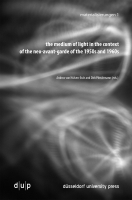Carolin Höfler: „Structure, Fluctuation and Self Organization. On the Bauhaus Reception by György Kepes“, in: Andrea von Hülsen-Esch, Dirk Pörschmann (Eds.): The Medium of Light in the Context of the Neo-Avant-Garde of the 1950s and 1960s. Düsseldorf: University Press 2013, S. 137–176. [mehr]
The text contribution examines the interdependencies between the founder of the Center for Advanced Visual Studies at the MIT, György Kepes, and leading protagonists of De Stijl and Bauhaus, who had mostly emigrated to the United States in 1930s. The purpose is to relate the artistic vision of form as unity of opposites, as equilibrium and pattern of interacting forces to Kepes' concept of structure in art and science. The Concrete Art movement is defined by themes and techniques (e.g., the ambiguous relationship between figure and ground, the dynamic perception of multiple perspectives or the dematerialization by light structures), which provide visual forms of expression for the synthesis of contemporary art, science and technology propagated by Kepes. A central role in seeing the world of knowledge as an interconnected whole have also played the lightweight constructions of Richard Buckminster Fuller and Frei Otto. The ideas of "self-formation" and "natural construction" served Kepes as models of a "renewed marriage of art and science, art and nature".
Der Textbeitrag untersucht die Wechselbeziehungen zwischen dem Gründer des Center for Advanced Visual Studies am MIT, György Kepes, und führenden Protagonisten der De-Stijl-Gruppe und des Bauhauses, die mehrheitlich in den 1930er Jahren in die USA auswanderten. Ziel ist es, die künstlerisch bestimmte Idee der Form als Einheit der Gegensätze, als Gleichgewicht und Beispiel zusammenwirkender Kräfte mit Kepes' Konzept der Struktur in Kunst und Wissenschaft in Beziehung zu setzen. Die Konkrete Kunst wird durch Themen und Techniken bestimmt (z. B. die mehrdeutigen Figur-Grund-Beziehungen, die dynamische Wahrnehmung multipler Perspektiven oder die Entmaterialisierung durch Lichtstrukturen), die visuelle Ausdrucksformen für die von Kepes propagierte Synthese zeitgenössischer Kunst, Wissenschaft und Technologie bereitstellen. Eine zentrale Rolle in der Wahrnehmung der Welt des Wissens als ein verbundenes Ganzes spielten auch die leichtgewichtigen Baukonstruktionen von Richard Buckminster Fuller und Frei Otto. Die Ideen der „Selbstformation“ und der „natürlichen Konstruktion“ dienten Kepes als Modelle für eine „erneuerte Paarung von Kunst und Wissenschaft, von Kunst und Natur“.
Carolin Höfler: „Structure, Fluctuation and Self Organization. On the Bauhaus Reception by György Kepes“, in: Andrea von Hülsen-Esch, Dirk Pörschmann (Eds.): The Medium of Light in the Context of the Neo-Avant-Garde of the 1950s and 1960s. Düsseldorf: University Press 2013, S. 137–176. [mehr]
The text contribution examines the interdependencies between the founder of the Center for Advanced Visual Studies at the MIT, György Kepes, and leading protagonists of De Stijl and Bauhaus, who had mostly emigrated to the United States in 1930s. The purpose is to relate the artistic vision of form as unity of opposites, as equilibrium and pattern of interacting forces to Kepes' concept of structure in art and science. The Concrete Art movement is defined by themes and techniques (e.g., the ambiguous relationship between figure and ground, the dynamic perception of multiple perspectives or the dematerialization by light structures), which provide visual forms of expression for the synthesis of contemporary art, science and technology propagated by Kepes. A central role in seeing the world of knowledge as an interconnected whole have also played the lightweight constructions of Richard Buckminster Fuller and Frei Otto. The ideas of "self-formation" and "natural construction" served Kepes as models of a "renewed marriage of art and science, art and nature".
Der Textbeitrag untersucht die Wechselbeziehungen zwischen dem Gründer des Center for Advanced Visual Studies am MIT, György Kepes, und führenden Protagonisten der De-Stijl-Gruppe und des Bauhauses, die mehrheitlich in den 1930er Jahren in die USA auswanderten. Ziel ist es, die künstlerisch bestimmte Idee der Form als Einheit der Gegensätze, als Gleichgewicht und Beispiel zusammenwirkender Kräfte mit Kepes' Konzept der Struktur in Kunst und Wissenschaft in Beziehung zu setzen. Die Konkrete Kunst wird durch Themen und Techniken bestimmt (z. B. die mehrdeutigen Figur-Grund-Beziehungen, die dynamische Wahrnehmung multipler Perspektiven oder die Entmaterialisierung durch Lichtstrukturen), die visuelle Ausdrucksformen für die von Kepes propagierte Synthese zeitgenössischer Kunst, Wissenschaft und Technologie bereitstellen. Eine zentrale Rolle in der Wahrnehmung der Welt des Wissens als ein verbundenes Ganzes spielten auch die leichtgewichtigen Baukonstruktionen von Richard Buckminster Fuller und Frei Otto. Die Ideen der „Selbstformation“ und der „natürlichen Konstruktion“ dienten Kepes als Modelle für eine „erneuerte Paarung von Kunst und Wissenschaft, von Kunst und Natur“.
